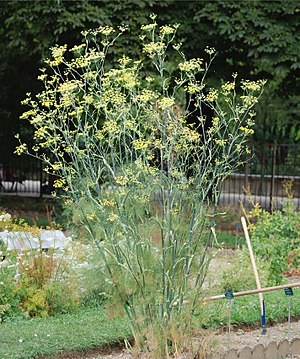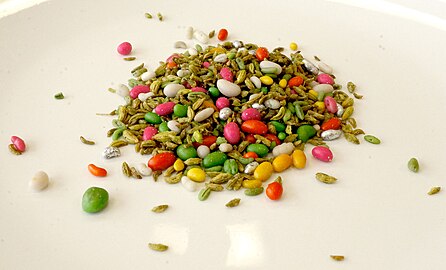Fennel/ja: Difference between revisions
Created page with "''Foeniculum vulgare'' 'Purpureum' または 'Nigra'、「ブロンズ葉フェンネル」は、装飾的な庭園植物として広く入手可能である。" Tags: Mobile edit Mobile web edit |
Created page with "== 文化{{Anchor|Culture}} ==" Tags: Mobile edit Mobile web edit |
||
| (21 intermediate revisions by the same user not shown) | |||
| Line 83: | Line 83: | ||
''Foeniculum vulgare'' 'Purpureum' または 'Nigra'、「ブロンズ葉フェンネル」は、装飾的な庭園植物として広く入手可能である。 | ''Foeniculum vulgare'' 'Purpureum' または 'Nigra'、「ブロンズ葉フェンネル」は、装飾的な庭園植物として広く入手可能である。 | ||
フェンネルは、北ヨーロッパ、米国、[[:en:Canada|カナダ]]南部、アジアの大部分、[[:en:Australia|オーストラリア]]など、多くの地域の道端、牧草地、その他の開けた場所で[[naturalisation (biology)/ja|帰化]]している。根冠と種子の両方でよく繁殖し、オーストラリアと米国では[[invasive species/ja|外来種]]および[[weed/ja|雑草]]と見なされている。フェンネルは、草地、海岸の低木地、[[:en:Riparian zone|河畔]]、湿地の群落など、多くの植物群落の構成と構造を劇的に変化させる可能性がある。これは、光、栄養素、水について在来種を凌駕することで、またおそらく他の植物の成長を阻害する[[Allelopathy/ja|アレロパシー]]物質を分泌することによってこれを行っているようである。北米西部では、フェンネルは海岸および内陸の[[:en:wildland-urban interface|ワイルドランド・アーバン・インターフェース]]から東に丘陵地や山岳地帯まで見られるが、砂漠の生息地には見られない。例えば、[[:en:Santa Cruz Island|サンタクルーズ島]](カリフォルニア州)では、フェンネルが50〜90%の絶対被覆率を達成している。 | |||
===生産=== | |||
=== | [[:en:United Nations|国際連合]][[:en:Food and Agriculture Organization|食糧農業機関]]によって分類されているように、フェンネルの生産データは、アニス、スターアニス、[[coriander/ja|コリアンダー]]といった類似のスパイスと合わせて集計されている。2014年には、[[:en:India|インド]]が世界のフェンネル生産量の60%を占め、[[:en:China|中国]]と[[:en:Bulgaria|ブルガリア]]が主要な二次生産国であった。 | ||
{| class="wikitable" | {| class="wikitable" | ||
|+ Production of fennel – 2014 | |+ Production of fennel – 2014 | ||
|- | |- | ||
! scope="col" | | ! scope="col" | 国 | ||
! scope="col" | | ! scope="col" | 生産<br /><small>([[:en:tonne|トン]])</small> | ||
|- | |- | ||
| {{IND}} || 584,000 | | {{IND}} || 584,000 | ||
| Line 113: | Line 108: | ||
| '''World''' || '''970,404''' | | '''World''' || '''970,404''' | ||
|- | |- | ||
| colspan="2" style="max-width: 18em;" | <small> | | colspan="2" style="max-width: 18em;" | <small>この情報は、[[:en:United Nations|国連]]の統計データベースである[[Wikipedia:FAOSTAT|FAOSTAT]]から取得されたもので、フェンネルの生産データが、アニス、スターアニス、コリアンダーといった関連スパイスとまとめて集計されていることを示している。</small> | ||
|} | |} | ||
< | <span id="Uses"></span> | ||
== Uses == | == 用途{{Anchor|Uses}} == | ||
フェンネルは古代ギリシャ人やローマ人に珍重され、彼らは薬、食料、虫よけとして使用した。フェンネル茶は、戦いの前に戦士に勇気を与えると信じられていた。ギリシャ神話によると、[[:en:Prometheus|プロメテウス]]は巨大なフェンネルの茎を使って、[[:en:Mount Olympus|オリンポス山]]から地上に火を運んだ。[[:en:Charlemagne|カール大帝]]は、すべての帝国農場でのフェンネルの栽培を義務付けた。 | |||
フローレンスフェンネルは、ヨーロッパで薬用エリクサーとして始まり、19世紀後半にはフランスや他の国々で人気のアルコール飲料となった[[absinthe/ja|アブサン]]の調製に使われる3つの主要なハーブの1つである。フェンネルは、その薬効のために中国の[[:en:Materia medica|本草]]にも記載されている。 | |||
2016年の研究では、''F. vulgare''の精油に[[:en:insecticidal|殺虫性]]があることが判明した。 | |||
=== 栄養 === | |||
{{nutritional value/ja | |||
{{nutritional value | | name = フェンネルシード | ||
| name = | |||
| kJ = 1443 | | kJ = 1443 | ||
| water = 8.8 g | | water = 8.8 g | ||
| Line 161: | Line 147: | ||
| note = [https://fdc.nal.usda.gov/fdc-app.html#/food-details/171323/nutrients Link to Full USDA Database entry] | | note = [https://fdc.nal.usda.gov/fdc-app.html#/food-details/171323/nutrients Link to Full USDA Database entry] | ||
}} | }} | ||
生のフェンネル球根は、90%が水分、1%が[[protein (nutrient)/ja|タンパク質]]、7%が[[carbohydrate/ja|炭水化物]]であり、ごくわずかな[[fat/ja|脂肪]]しか含まれていない。 | |||
乾燥フェンネルシードは通常、ごく少量でスパイスとして使用される。100gのフェンネルシードは、1,444kJ (345kcal)の食物エネルギーを提供し、タンパク質、食物繊維、[[B vitamins/ja|ビタミンB群]]、およびいくつかの[[Dietary minerals/ja|ミネラル]]、特に[[Calcium/ja|カルシウム]]、[[Iron/ja|鉄]]、[[Magnesium/ja|マグネシウム]]、[[Manganese/ja|マンガン]]が豊富に含まれており([[Daily Value/ja|1日の摂取量]]の20%以上)、これらすべてがDVの90%を超えている。フェンネルシードは、52%が炭水化物(40%が[[Dietary fiber/ja|食物繊維]])、15%が[[Fat/ja|脂肪]]、16%がタンパク質、9%が水分である。 | |||
=== 料理 === | |||
{{Cookbook|Fennel}} | {{Cookbook|Fennel}} | ||
フェンネルの球根、葉、果実は、世界の多くの料理の伝統で利用されている。野生のフェンネルの小さな花(フェンネルの「花粉」として知られる)は、フェンネルの最も強力な形態であるが、最も高価でもある。乾燥フェンネルの果実は、芳香があり、アニス風味の[[Spice/ja|スパイス]]で、新鮮なときは茶色または緑色だが、果実が熟すとゆっくりとくすんだ灰色に変わる。料理には、緑色の果実が最適である。葉は繊細な風味があり、ディルに似た形をしている。球根は歯ごたえのある野菜で、ソテー、煮込み、ブレゼ、グリル、または生で食べることができる。柔らかい若葉は、飾り付けに、サラダとして、サラダの風味付けに、プディングに添えるソースの風味付けに、スープや魚醤に使われる。膨らんだ葉の付け根と柔らかい若い[[Shoot (botany)/ja|芽]]の両方を[[Celery/ja|セロリ]]のように食べることができる。 | |||
フェンネルの果実は、味や見た目が似ているが小さいアニスの果実と混同されることがある。フェンネルは、一部の天然[[:en:Toothpaste|歯磨き粉]]の香料としても使われている。果実は料理や甘いデザートに使われる。 | |||
インド、[[:en:Afghanistan|アフガニスタン]]、[[:en:Iran|イラン]]、[[:en:Middle East|中東]]の多くの文化では、料理にフェンネルの果実を使用する。イラクでは、フェンネルシードは[[Nigella/ja|ニゲラ]]風味のパンの材料として使われる。[[Kashmiri cuisine/ja|カシミール料理]]や[[Gujarati cuisine/ja|グジャラート料理]]において最も重要なスパイスの1つである。インド料理では、丸ごとのフェンネルシードとフェンネルパウダーが、様々な甘い料理や塩味の料理のスパイスとして使われる。[[Assamese cuisine/ja|アッサム]]/[[Bengali cuisine/ja|ベンガル]]/[[Oriya cuisine/ja|オリッサ]]のスパイスミックス「[[panch phoron/ja|パンチフォロン]]」や、中国の[[five-spice powder/ja|五香粉]]に不可欠な材料である。インドの多くの地域では、焙煎したフェンネルの果実が、食後の消化剤や口臭清涼剤(サウンフ)として「[[:en:Mukhwas|ムクワス]]」として消費されたり、[[Comfit/ja|糖衣がけ]]される。フェンネルシードは、インドで最も人気のある口臭清涼剤である[[:en:Paan|パーン]]の材料としてもよく使われる。中国では、フェンネルの茎と葉は、[[Jiaozi/ja|餃子]]、[[Baozi/ja|包子]]、または[[Pie/ja|パイ]]の餡の材料として、また冷菜の青野菜としてもよく使われる。フェンネルの果実は、五香粉や{{Interlanguage link|thirteen-spice powder|lt=thirteen-spice powder|zh|十三香}}などの有名なミックススパイスに含まれている。 | |||
インドの一部地域では、フェンネルの葉は葉物野菜として、単独で、または他の野菜と混ぜて、食事の一部として調理され消費される。[[:en:Syria|シリア]]や[[:en:Lebanon|レバノン]]では、若い葉を使って「''{{lang|ar-Latn|[[eggah/ja|イッジェ]]}}''」と呼ばれる特別な種類の卵のオムレツ(タマネギと小麦粉も一緒に)を作る。 | |||
多くの[[Egg (food)/ja|卵料理]]、[[Fish (food)/ja|魚料理]]、その他の料理には、生または乾燥させたフェンネルの葉が使われる。フローレンスフェンネルは、一部のイタリアンサラダの主要な材料であり、またブレゼして温かい付け合わせとして提供することもできる。[[Blanching (cooking)/ja|湯通し]]したり、[[Marinade/ja|マリネ]]したり、[[Risotto/ja|リゾット]]で調理することもできる。 | |||
フェンネルの果実は、[[Italian sausage/ja|イタリアンソーセージ]]の主要な風味成分である。スペインでは、フェンネルの茎が、ピクルスにしたナス「''{{lang|es|berenjenas de Almagro}}''」の準備に使われる。[[Herbal tea/ja|ハーブティー]]や「[[Tisane/ja|ティザンヌ]]」もフェンネルから作ることができる。 | |||
その芳香性から、フェンネルの果実は、よく知られている配合[[Liquorice powder/ja|リコリスパウダー]]の成分の1つを形成する。インド亜大陸では、フェンネルの果実は生で食べられ、時には甘味料と一緒に食べられる。 | |||
{{gallery|mode=packed | {{gallery|mode=packed | ||
|Saunf sweets.JPG| | |Saunf sweets.JPG|[[:en:Breath freshener|口臭清涼剤]]として使われる、砂糖で覆われたフェンネルの果実と覆われていないフェンネルの果実 | ||
|Fennel seeds and rock sugar, Indian aftermint.jpg| | |Fennel seeds and rock sugar, Indian aftermint.jpg|フェンネルシードと氷砂糖で作られたインドの「[[:en:Mukhwas|ムクワス]]」(口臭清涼剤) | ||
|Fenouil cuisiné avec du cabillaud à la crème d'aneth.JPG| | |Fenouil cuisiné avec du cabillaud à la crème d'aneth.JPG|[[Cod/ja|タラ]]と[[Dill/ja|ディル]]クリームを詰めて調理されたフランスのフェンネル | ||
|Fennel pie at Huatian Eryouju, Maliandao (20220214134542).jpg| | |Fennel pie at Huatian Eryouju, Maliandao (20220214134542).jpg|フェンネル餡の中国式「[[Bing (bread)/ja|ビン]]」 | ||
}} | }} | ||
< | <span id="Culture"></span> | ||
== Culture == | == 文化{{Anchor|Culture}} == | ||
フェンネルのギリシャ語名は''marathon'' ({{lang|grc|μάραθον}}) または''marathos'' ({{lang|grc|μάραθος}}) であり、有名な[[:en:Battle of Marathon|マラトンの戦い]]の場所は文字通りフェンネルのある平原を意味する。この言葉は、[[:en:Mycenaean Greek|ミケーネ語]][[:en:Linear B|線文字B]]の''{{lang|gmy|ma-ra-tu-wo}}''という形で最初に記録されている。[[:en:Hesiod|ヘシオドス]]の『[[:en:Theogony|神統記]]』では、[[:en:Prometheus|プロメテウス]]が神々から火の残り火を、中空のフェンネルの茎に隠して盗む。 | |||
[[:en:Old English|古英語]]の''{{lang|ang|finule}}''として、フェンネルは10世紀に記録された[[:en:Anglo-Saxon paganism|アングロサクソン異教]]の『[[Wikipedia:Nine Herbs Charm|Nine Herbs Charm]]』で祈願される9つの植物の1つである。 | |||
15世紀、[[:en:Madeira|マデイラ島]]のポルトガル人入植者は野生のフェンネルが豊富にあることに気づき、[[:en:Portuguese language|ポルトガル語]]の''[[wikt:funcho#Portuguese|funcho]]''(フェンネル)と接尾辞''{{lang|pt|-al}}''を使って新しい町の名前を形成し、[[:en:Funchal|フンシャル]]と名付けた。 | |||
[[:en:Henry Wadsworth Longfellow|ヘンリー・ワズワース・ロングフェロー]]の1842年の詩「The Goblet of Life」は、この植物に繰り返し言及し、視力を強化するとされるその能力について述べている: | |||
[[Henry Wadsworth Longfellow]] | |||
<blockquote><poem>Above the lower plants, it towers, | <blockquote><poem>Above the lower plants, it towers, | ||
The Fennel with its yellow flowers; | The Fennel with its yellow flowers; | ||
| Line 240: | Line 193: | ||
Lost vision to restore.</poem></blockquote> | Lost vision to restore.</poem></blockquote> | ||
{{Clear|left}} | {{Clear|left}} | ||
== 外部リンク == | == 外部リンク == | ||
Latest revision as of 19:40, 5 June 2025
| Fennel/ja | |
|---|---|

| |
| 花のフェンネル | |
| Scientific classification | |
| Kingdom: | Plantae |
| Clade: | Tracheophytes |
| Clade: | Angiosperms |
| Clade: | Eudicots |
| Clade: | Asterids |
| Order: | Apiales |
| Family: | Apiaceae |
| Genus: | Foeniculum |
| Species: | vulgare
|
| Binomial name | |
| vulgare | |
| Synonyms | |
|
List
| |
フェンネル(Foeniculum vulgare)は、セリ科の顕花植物の一種である。丈夫な耐寒性の多年生ハーブで、黄色の花と羽毛のような葉を持つ。地中海沿岸が原産であるが、世界の多くの地域、特に海沿いの乾燥した土壌や川岸に広く帰化している。
これは料理に使われる非常に風味豊かなハーブで、同様の味を持つアニスとともに、アブサンの主要な材料の一つである。フローレンスフェンネルまたはフィノッキオ(UK: /fɪˈnɒkioʊ/、US: /-ˈnoʊk-/、it)は、膨らんだ球根状の茎の根元(時に「球根フェンネル」と呼ばれる)を持つ品種で、野菜として使われる。
形態
フェンネル(Foeniculum vulgare)は多年生のハーブである。茎は中空で直立し、灰白色を帯びた緑色で、高さは最大2.1メートルに達する。葉は長さ40センチメートルまで成長し、細かく裂けており、最終的な裂片は糸状で、幅は約0.5ミリメートルである。その葉はディルの葉に似るが、より細い。
花は、幅5〜17.5センチメートルの頂生複合散形花序に形成され、各散形花序には短い花柄に20〜50個の小さな黄色の花がつく。果実は長さ4〜10ミリメートル、幅はその半分以下で溝のある乾燥した分離果である。果実内の種子は果皮に付着しているため、果実全体が「種子」と誤って呼ばれることが多い。
-
フローレンスフェンネルの球根
-
花序
-
散形花序
-
果実
-
『Köhler's Medicinal Plants』(1887年)より
成分
フェンネルの果実の芳香性は、様々な香りを放つ揮発性油に由来する。これには、トランス-アネトールやエストラゴール(リコリスに似る)、フェンコン(ミントやカンファー)、リモネン、1-オクテン-3-オール(キノコ)などが含まれる。フェンネルの果実に見られる他の植物化学物質には、ポリフェノールであるロスマリン酸やルテオリンなどが少量含まれる。
類似種
セリ科の一部の植物は有毒であり、識別が難しいことが多い。
ディル、コリアンダー、アジョワン、キャラウェイは見た目が似ているハーブだが、フェンネルより丈が低く、40〜60センチメートルにしかならない。ディルには糸状の羽毛のような葉と黄色の花がある。コリアンダーとキャラウェイには白い花と細かく裂けた葉がある(ただし、ディルやフェンネルほど細かくはない)。また、これらは寿命も短い(一年草または二年草)。これらの種子間の表面的な類似性は、キャラウェイの別名であるメリディアンフェンネルのように、名前や語源の共有につながった可能性がある。
ジャイアントフェンネル(Ferula communis)は、地中海地方に自生し、他の地域ではごくまれに庭園で栽培される、刺激的な香りを持つ大きくて粗い植物である。Ferula属の他の種もジャイアントフェンネルと呼ばれるが、これらは料理用ハーブではない。
北米では、フェンネルが同じ生息地で、パセリ科の有用な薬用植物である在来種のオシャ(Ligusticum porteri)やLomatium種とともに生育しているのが見られることがある。
ほとんどのLomatium種はフェンネルのような黄色の花を咲かせるが、一部は白い花を咲かせ、ドクゼリに似ている。Lomatiumは「ビスケットルート」として知られるアメリカ先住民の重要な歴史的食料植物である。ほとんどのLomatium種は細かく裂けた毛のような葉を持つ。その根はドクゼリのカビ臭い匂いとは異なり、繊細な米のような匂いがする。Lomatium種は、有機物のない乾燥した岩だらけの土壌を好む。
語源
「フェンネル」は古フランス語のfenoilから古英語に入り、それはさらにラテン語のfaeniculumに由来する。この語は「干し草」を意味するfaenumの指小辞である。
栽培

フェンネルは、その食用となる風味豊かな葉と果実のために、自生地およびその他の地域で広く栽培されている。そのアニスまたはリコリスのような風味は、アニスやスターアニスにも含まれる芳香化合物であるアネトールに由来しており、その味と香りはそれらに似ているが、通常はそれほど強くはない。
フローレンスフェンネル(Foeniculum vulgare Azoricum Group; シノニム F. vulgare var. azoricum)は、球根状の構造を形成する膨らんだ葉の基部を持つ栽培品種群である。これは栽培起源であり、穏やかなアニスのような風味を持つが、より甘く芳香がある。フローレンスフェンネルの植物は野生種よりも小さい。フローレンスフェンネルのいくつかの栽培品種は、特にイタリア語名finocchioなど、いくつかの他の名前でも知られている。北米のスーパーマーケットでは、「アニス」と誤表示されていることが多い。
Foeniculum vulgare 'Purpureum' または 'Nigra'、「ブロンズ葉フェンネル」は、装飾的な庭園植物として広く入手可能である。
フェンネルは、北ヨーロッパ、米国、カナダ南部、アジアの大部分、オーストラリアなど、多くの地域の道端、牧草地、その他の開けた場所で帰化している。根冠と種子の両方でよく繁殖し、オーストラリアと米国では外来種および雑草と見なされている。フェンネルは、草地、海岸の低木地、河畔、湿地の群落など、多くの植物群落の構成と構造を劇的に変化させる可能性がある。これは、光、栄養素、水について在来種を凌駕することで、またおそらく他の植物の成長を阻害するアレロパシー物質を分泌することによってこれを行っているようである。北米西部では、フェンネルは海岸および内陸のワイルドランド・アーバン・インターフェースから東に丘陵地や山岳地帯まで見られるが、砂漠の生息地には見られない。例えば、サンタクルーズ島(カリフォルニア州)では、フェンネルが50〜90%の絶対被覆率を達成している。
生産
国際連合食糧農業機関によって分類されているように、フェンネルの生産データは、アニス、スターアニス、コリアンダーといった類似のスパイスと合わせて集計されている。2014年には、インドが世界のフェンネル生産量の60%を占め、中国とブルガリアが主要な二次生産国であった。
| 国 | 生産 (トン) |
|---|---|
| 584,000 | |
| 48,002 | |
| 36,500 | |
| 32,771 | |
| 29,251 | |
| 27,668 | |
| World | 970,404 |
| この情報は、国連の統計データベースであるFAOSTATから取得されたもので、フェンネルの生産データが、アニス、スターアニス、コリアンダーといった関連スパイスとまとめて集計されていることを示している。 | |
用途
フェンネルは古代ギリシャ人やローマ人に珍重され、彼らは薬、食料、虫よけとして使用した。フェンネル茶は、戦いの前に戦士に勇気を与えると信じられていた。ギリシャ神話によると、プロメテウスは巨大なフェンネルの茎を使って、オリンポス山から地上に火を運んだ。カール大帝は、すべての帝国農場でのフェンネルの栽培を義務付けた。
フローレンスフェンネルは、ヨーロッパで薬用エリクサーとして始まり、19世紀後半にはフランスや他の国々で人気のアルコール飲料となったアブサンの調製に使われる3つの主要なハーブの1つである。フェンネルは、その薬効のために中国の本草にも記載されている。
2016年の研究では、F. vulgareの精油に殺虫性があることが判明した。
栄養
| 100 g (3.5 oz)あたりの栄養価 | |||||||||||||||||||||||||||||||||||||||
|---|---|---|---|---|---|---|---|---|---|---|---|---|---|---|---|---|---|---|---|---|---|---|---|---|---|---|---|---|---|---|---|---|---|---|---|---|---|---|---|
| エネルギー | 1,443 kJ (345 kcal) | ||||||||||||||||||||||||||||||||||||||
52 g | |||||||||||||||||||||||||||||||||||||||
| 食物繊維 | 40 g | ||||||||||||||||||||||||||||||||||||||
14.9 g | |||||||||||||||||||||||||||||||||||||||
| 飽和 | 0.5 g | ||||||||||||||||||||||||||||||||||||||
| 一価不飽和 | 9.9 g | ||||||||||||||||||||||||||||||||||||||
| 多価不飽和 | 1.7 g | ||||||||||||||||||||||||||||||||||||||
15.8 g | |||||||||||||||||||||||||||||||||||||||
| |||||||||||||||||||||||||||||||||||||||
| その他の成分 | 量 | ||||||||||||||||||||||||||||||||||||||
| 水 | 8.8 g | ||||||||||||||||||||||||||||||||||||||
| †割合は、カリウムを除き、成人に対する米国 推奨値を使用して推定された。カリウムは、全米科学・工学・医学アカデミーの専門家による推奨に基づき推定された。 | |||||||||||||||||||||||||||||||||||||||
生のフェンネル球根は、90%が水分、1%がタンパク質、7%が炭水化物であり、ごくわずかな脂肪しか含まれていない。
乾燥フェンネルシードは通常、ごく少量でスパイスとして使用される。100gのフェンネルシードは、1,444kJ (345kcal)の食物エネルギーを提供し、タンパク質、食物繊維、ビタミンB群、およびいくつかのミネラル、特にカルシウム、鉄、マグネシウム、マンガンが豊富に含まれており(1日の摂取量の20%以上)、これらすべてがDVの90%を超えている。フェンネルシードは、52%が炭水化物(40%が食物繊維)、15%が脂肪、16%がタンパク質、9%が水分である。
料理
フェンネルの球根、葉、果実は、世界の多くの料理の伝統で利用されている。野生のフェンネルの小さな花(フェンネルの「花粉」として知られる)は、フェンネルの最も強力な形態であるが、最も高価でもある。乾燥フェンネルの果実は、芳香があり、アニス風味のスパイスで、新鮮なときは茶色または緑色だが、果実が熟すとゆっくりとくすんだ灰色に変わる。料理には、緑色の果実が最適である。葉は繊細な風味があり、ディルに似た形をしている。球根は歯ごたえのある野菜で、ソテー、煮込み、ブレゼ、グリル、または生で食べることができる。柔らかい若葉は、飾り付けに、サラダとして、サラダの風味付けに、プディングに添えるソースの風味付けに、スープや魚醤に使われる。膨らんだ葉の付け根と柔らかい若い芽の両方をセロリのように食べることができる。
フェンネルの果実は、味や見た目が似ているが小さいアニスの果実と混同されることがある。フェンネルは、一部の天然歯磨き粉の香料としても使われている。果実は料理や甘いデザートに使われる。
インド、アフガニスタン、イラン、中東の多くの文化では、料理にフェンネルの果実を使用する。イラクでは、フェンネルシードはニゲラ風味のパンの材料として使われる。カシミール料理やグジャラート料理において最も重要なスパイスの1つである。インド料理では、丸ごとのフェンネルシードとフェンネルパウダーが、様々な甘い料理や塩味の料理のスパイスとして使われる。アッサム/ベンガル/オリッサのスパイスミックス「パンチフォロン」や、中国の五香粉に不可欠な材料である。インドの多くの地域では、焙煎したフェンネルの果実が、食後の消化剤や口臭清涼剤(サウンフ)として「ムクワス」として消費されたり、糖衣がけされる。フェンネルシードは、インドで最も人気のある口臭清涼剤であるパーンの材料としてもよく使われる。中国では、フェンネルの茎と葉は、餃子、包子、またはパイの餡の材料として、また冷菜の青野菜としてもよく使われる。フェンネルの果実は、五香粉やthirteen-spice powderなどの有名なミックススパイスに含まれている。
インドの一部地域では、フェンネルの葉は葉物野菜として、単独で、または他の野菜と混ぜて、食事の一部として調理され消費される。シリアやレバノンでは、若い葉を使って「イッジェ」と呼ばれる特別な種類の卵のオムレツ(タマネギと小麦粉も一緒に)を作る。
多くの卵料理、魚料理、その他の料理には、生または乾燥させたフェンネルの葉が使われる。フローレンスフェンネルは、一部のイタリアンサラダの主要な材料であり、またブレゼして温かい付け合わせとして提供することもできる。湯通ししたり、マリネしたり、リゾットで調理することもできる。
フェンネルの果実は、イタリアンソーセージの主要な風味成分である。スペインでは、フェンネルの茎が、ピクルスにしたナス「berenjenas de Almagro」の準備に使われる。ハーブティーや「ティザンヌ」もフェンネルから作ることができる。
その芳香性から、フェンネルの果実は、よく知られている配合リコリスパウダーの成分の1つを形成する。インド亜大陸では、フェンネルの果実は生で食べられ、時には甘味料と一緒に食べられる。
文化
フェンネルのギリシャ語名はmarathon (μάραθον) またはmarathos (μάραθος) であり、有名なマラトンの戦いの場所は文字通りフェンネルのある平原を意味する。この言葉は、ミケーネ語線文字Bのma-ra-tu-woという形で最初に記録されている。ヘシオドスの『神統記』では、プロメテウスが神々から火の残り火を、中空のフェンネルの茎に隠して盗む。
古英語のfinuleとして、フェンネルは10世紀に記録されたアングロサクソン異教の『Nine Herbs Charm』で祈願される9つの植物の1つである。
15世紀、マデイラ島のポルトガル人入植者は野生のフェンネルが豊富にあることに気づき、ポルトガル語のfuncho(フェンネル)と接尾辞-alを使って新しい町の名前を形成し、フンシャルと名付けた。
ヘンリー・ワズワース・ロングフェローの1842年の詩「The Goblet of Life」は、この植物に繰り返し言及し、視力を強化するとされるその能力について述べている:
Above the lower plants, it towers,
The Fennel with its yellow flowers;
And in an earlier age than ours
Was gifted with the wondrous powers
Lost vision to restore.
外部リンク
| この記事は、クリエイティブ・コモンズ・表示・継承ライセンス3.0のもとで公表されたウィキペディアの項目Fennel(22 May 2025, at 22:02編集記事参照)を翻訳して二次利用しています。 |








